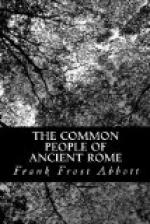In the early part of this chapter the tendency of the Romans to form voluntary associations was noted as a national characteristic. This fact comes out very clearly if we compare the number of trades-unions in the Western world with those in Greece and the Orient. Our conclusions must be drawn of course from the extant inscriptions which refer to guilds, and time may have dealt more harshly with the stones in one place than in another, or the Roman government may have given its consent to the establishment of such organizations with more reluctance in one province than another; but, taking into account the fact that we have guild inscriptions from four hundred and seventy-five towns and villages in the Empire, these elements of uncertainty in our conclusions are practically eliminated, and a fair comparison may be drawn between conditions in the East and the West. If we pick out some of the more important towns in the Greek part of the Roman world, we find five guilds reported from Tralles in Caria, six from Smyrna, one from Alexandria, and eleven from Hierapolis in Phrygia. On the other hand, in the city of Rome there were more than one hundred, in Brixia (modern Brescia) seventeen or more, in Lugudunum (Lyons) twenty at least, and in Canabae, in the province of Dacia, five. These figures, taken at random for some of the larger towns in different parts of the Empire, bring out the fact very clearly that the western and northern provinces readily accepted Roman ideas and showed the Roman spirit, as illustrated in their ability and willingness to co-operate for a common purpose, but that the Greek East was never Romanized. Even in the settlements in Dacia, which continued under Roman rule only from 107 to 270 A.D., we find as many trades-unions as existed in Greek towns which were held by the Romans for three or four centuries. The comparative number of guilds and of guild inscriptions would, in fact, furnish us with a rough test of the extent to which Rome impressed her civilization on different parts of the Empire, even if we had no other criteria. We should know, for instance, that less progress had been made in Britain than in Southern Gaul, that Salona in Dalmatia, Lugudunum in Gaul, and Mogontiacum (Mainz) in Germany were important centres of Roman civilization. It is, of course, possible from a study of these inscriptions to make out the most flourishing industries in the several towns, but with that we are not concerned here.
These guilds which we have been considering were trades-unions in the sense that they were organizations made up of men working in the same trade, but they differed from modern unions, and also from mediaeval guilds, in the objects for which they were formed. They made no attempt to raise wages, to improve working conditions, to limit the number of apprentices, to develop skill and artistic taste in the craft, or to better the social or political position of the laborer. It was the need which their members felt for companionship,




